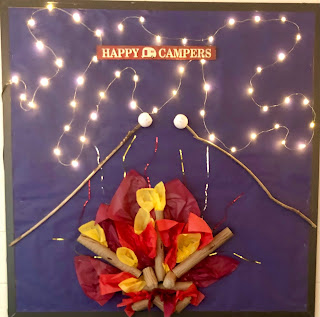Are you gearing up for an extraordinary brand-new school year? This is the time of year when I get excited about planning and organizing my counseling space! With all the shiny new school supplies and blank wall canvases, it's the perfect time to make an inviting, calming, fun, and productive counseling office. I'm thrilled to share my many years of experience setting up and decorating 12 different office spaces, ranging from tiny offices to large classrooms. Over the years, I discovered my passion for creating a new theme for my school counseling office each year to change things up and jumpstart my year!
In a school setting, the counseling office plays a vital role in supporting students' emotional well-being and providing a safe space for guidance and support. However, it's important to recognize that the physical environment itself can significantly impact students' stress levels and their willingness to seek help. By creating a school counseling office that is designed to reduce stress and is inviting, we can enhance the overall effectiveness of the counseling services provided. Let’s check out my top tips for creating a comfortable and well-decorated space that can positively influence students' well-being and engagement; as well as bring you joy:
Space Considerations: Maximize efficiency by making the most of the available space. Whether you have a small office or a larger classroom, adapt the layout, furniture placement, and storage options accordingly. If you have a larger classroom, consider designating specific areas for different group sizes, including large groups, small groups, and a private counseling corner for one-on-one sessions. Even with a tiny office, you'd be amazed at what you can achieve by utilizing multifunctional furniture!

Thematic Touches: Add a theme to your counseling office for a visually appealing environment. You can choose personal themes related to mental health, personal growth, or inspirational quotes. One of my personal favorites was the Happy Campers theme. Alternatively, incorporate your school's colors and mascot to foster a sense of pride and connection. Here are some fun themes to consider:
- Feelings are Puzzling: Use puzzle pieces to decorate.
- A Sea of Feelings: Create a beach or sailboat theme.
- Happy Campers: Embrace a camping theme.
- Planting Seeds for the Future: Opt for a garden theme.
- A World of Help or Passport to a Great Year: Explore a travel theme.

Colorful and Calming: Choose a color scheme of soft, neutral tones or soothing pastels to create a calm and relaxed ambiance. Integrate natural light to boost mood and reduce stress. You can consider using window coverings for light control and privacy, or simply choose colors that make you happy. Remember, the happier you are, the more you can give to your students and school.
Comfortable Furniture: Whenever possible, select ergonomic chairs, couches, and tables to prioritize physical comfort. Provide a variety of seating options for individual and group sessions, as well as spaces for relaxation and reflection. Bean bags are favorites for my students and they are not very costly! If space is limited, functional and space-saving padded storage stools can be a great solution. You can see the dual-purpose stools below. You can sit on them as well as store small group supplies inside!
Personalized and Inclusive: Involve students in the design process to foster a sense of ownership and inclusivity. Encourage their contributions, such as artwork, quotes, or items reflecting their experiences and aspirations. Add inspirational quotes or posters, and celebrate diversity to enhance a sense of belonging. Use a whiteboard or chalkboard to display a new quote each month. Create a space for students to leave notes or messages. Here I have devoted a whiteboard for students to draw on and leave messages; as well as a table covered in poster board paper where students can leave doodles or inspirational notes to others:)

Private and Confidential: Design the layout in a way that ensures privacy and confidentiality. Strategically place seating away from doors and windows, ensuring students cannot be easily seen by everyone walking by. If covering door windows isn't allowed for safety purposes, make sure your students have a seating area away from the door and the visibility of passing classes.
Organized and Clutter-Free: Incorporate ample storage solutions, such as shelves, cabinets, or bins, to keep the counseling office organized. Ensure easy access to resources and label storage boxes for quick identification. Trust me, this helps with clean-up because you only need to pull out what is necessary instead of rummaging through every box!
Calming Elements: Integrate elements that promote relaxation and stress reduction, such as plants or a small indoor garden. Hang up calming artwork or photographs, and set up a sensory corner with fidget toys, stress balls. Have soft lighting for anxiety or stress management. My students absolutely love the café string lights in my room! They create a cozy and inviting ambiance. Below I have a picture of my office fish. Kids love watching him, instantly deflecting those high emotions!
Keep it updated: Change things up throughout the year to keep your space fresh and exciting. This could involve adding new decorations or simply rearranging the furniture. Here I used plastic plates from the Dollar Tree and Dry Erase Markers to change the quotes/signs!

- Increased productivity and well-being.
- Reduced stress levels.
- Enhanced creativity and innovation.
- Improved student engagement and collaboration.
- Boosted morale and motivation.
- Positive perception and trust-building.
By following these tips and creating a school counseling office that promotes a sense of comfort and well-being, you can have a profound impact on your students' emotional health, engagement, and overall success. I hope you have fun planning for a new year and embrace your creativity!
You may be interested in these Office Make-Over posts:

























